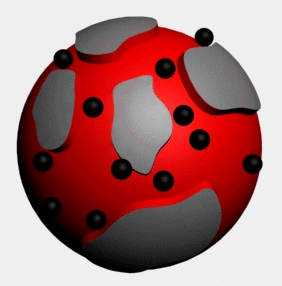博文
Minireview article: 作为低温燃料电池催化剂载体的纳米陶瓷材料
||
Haifeng Lv, Shichun Mu*. Nanoceramic Support Materials for Low Temperature Fuel CellCatalysts(点击下载) , Nanoscale,2014, 6 (10), 5063 - 5074 (minireview article)
当前影响低温燃料电池发展的一大影响因素是催化剂的电化学稳定性较差,这主要是因为催化剂载体为热力学极不稳定的碳材料,容易遭受电化学氧化,导致载体支撑的纳米金属催化剂颗粒发生脱落和团聚。采用碳纳米管、石墨烯等纳米石墨结构碳虽然能在一定程度上改善减缓了载体的电化学氧化动力学过程,当载体的电化学氧化仍难以避免。相比之下,纳米导电陶瓷(如SiC、TiB2、B2C、ZrB2等)具有较高的化学及电化学稳定性、较好的导电性能及优异的力学与热力学稳定性,可以极大地改善催化剂载体的电化学稳定性。此外,如果进一步采用有序化的纳米陶瓷材料,除了改善催化剂稳定性还可以增强传质能力,大幅提高催化剂的催化性能。但纳米导电陶瓷的缺点是其导电能力较碳材料差,如果采用纯的纳米陶瓷材料作为载体,将会降低催化剂的催化活性。为此,研究人员将碳导电剂引入陶瓷中制备了导电陶瓷/碳混杂材料、碳修饰纳米陶瓷材料,或对陶瓷进行异相金属原子掺杂,使催化剂的稳定性得到了极大提高。此外,利用过金属纳米粒子与陶瓷载体间的协同作用,不仅可以改善催化剂的催化活性,而且还可以提高催化剂的抗CO、SO2中毒能力。再者,通过采用具有氧还原反应活性(oxygen reductionreaction, ORR)的纳米陶瓷作为催化剂载体制备双功能催化剂,可有效地提高催化剂的电化学稳定性及电催化性能。最后,论文对今后选择高导电性的纳米陶瓷,对纳米陶瓷与石墨烯复合及在纳米陶瓷表表面进行活性金属原子层沉积等可能的研究发展方向进行了展望。

(图片版权属作者所有,不得下载、复制和使用)
Nano-ceramic support materials for low temperature fuel cell catalysts
Haifeng Lv and Shichun Mu*
State Key Laboratory of Advanced Technology for Materials Synthesis and Processing,
Wuhan University of Technology, Wuhan 430070, China. E-mail: msc@whut.edu.cn;
Fax: +86 27 87879468; Tel: +86 27 87651837
Abstract
Low temperature fuel cells (LTFCs) have received broad attention due to their low operating temperature, virtually zero emissions, high power density and efficiency. However, the limited stability of the catalysts is a critical limitation to the large scale commercialization of LTFCs. State of the art carbon supports undergo corrosion under harsh chemical and electrochemical oxidation conditions, which results in performance degradation of catalysts. Therefore, non-carbon materials which are highly oxidation resistant under strongly oxidizing conditions of LTFCs are ideal alternative supports. This minireview highlights the advances and scenarios in using nanoceramics as supports to enhance the stability of catalysts, the solutions to improve electrical conductivity of nanoceramic materials, and the synergistic effects between metal catalyst and support to help improve the catalytic activity and CO/SO2 tolerance of catalysts.
1 Introduction
2 Improving the stability of catalysts by employing electrochemically inert ceramics
2.1 Conducting metal oxides
2.2 Metal nitrides
2.3 Titanium diboride (TiB2)
3 Improving the electric conductivity of ceramics by hybridizing supports
3.1 Hybrid supports by introducing carbon
3.2 Hybrid supports by doping metal elements
3.3 Hybrid supports by introducing nano-ceramics into carbon supports
4 Improving the catalytic activity by synergistic effects
4.1 Improve the ORR activity
4.2 Improving the activity by ordered nano-ceramic supports
4.3 Improving the CO and SO2 poisoning resistance
4.4 Synergistic effect by co-catalyst function
5 Summary and outlook
https://blog.sciencenet.cn/blog-441048-803115.html
上一篇:《科学报告》:纳米导电陶瓷作为纳米楔改善石墨烯载Pt催化剂活性
下一篇:静电纺丝技术在低温燃料电池中的应用